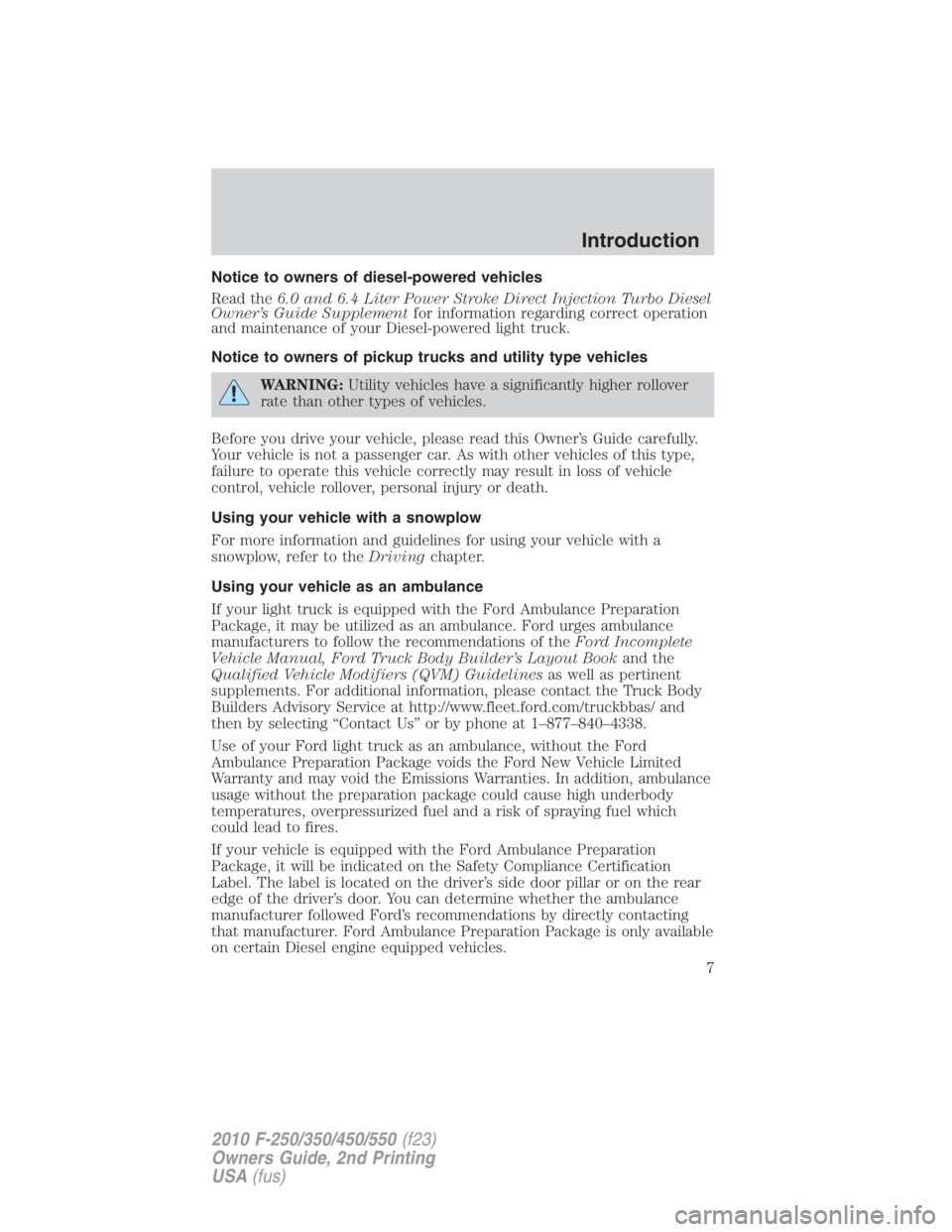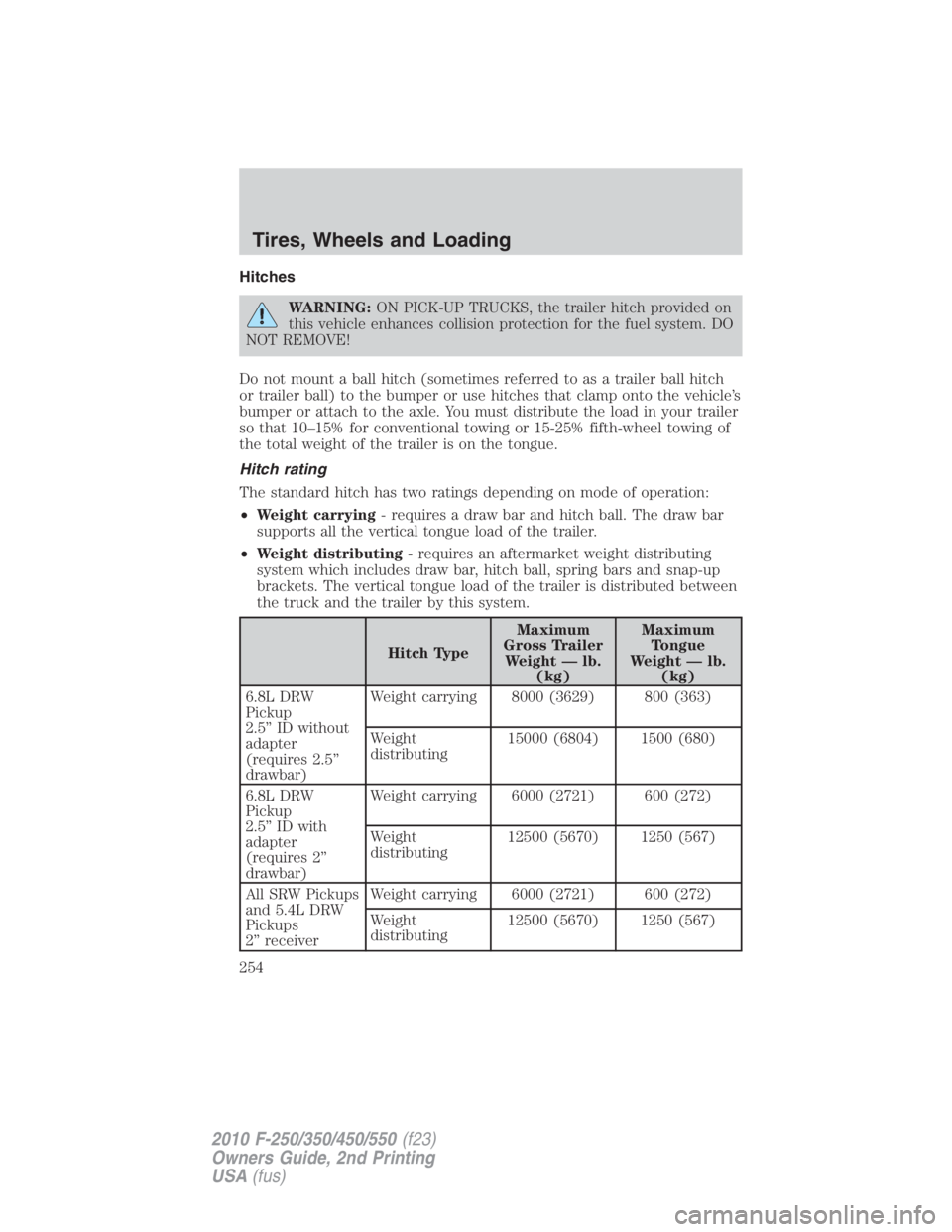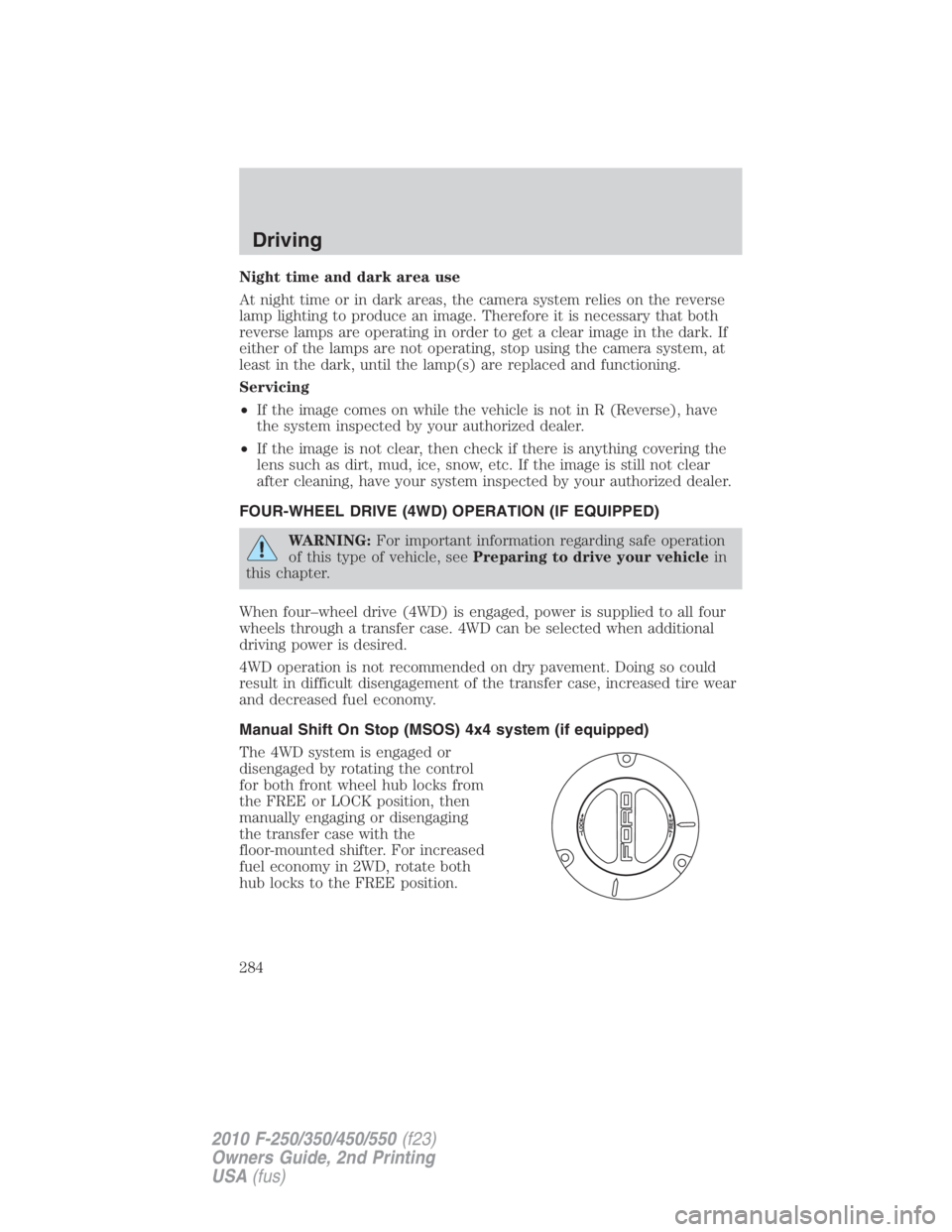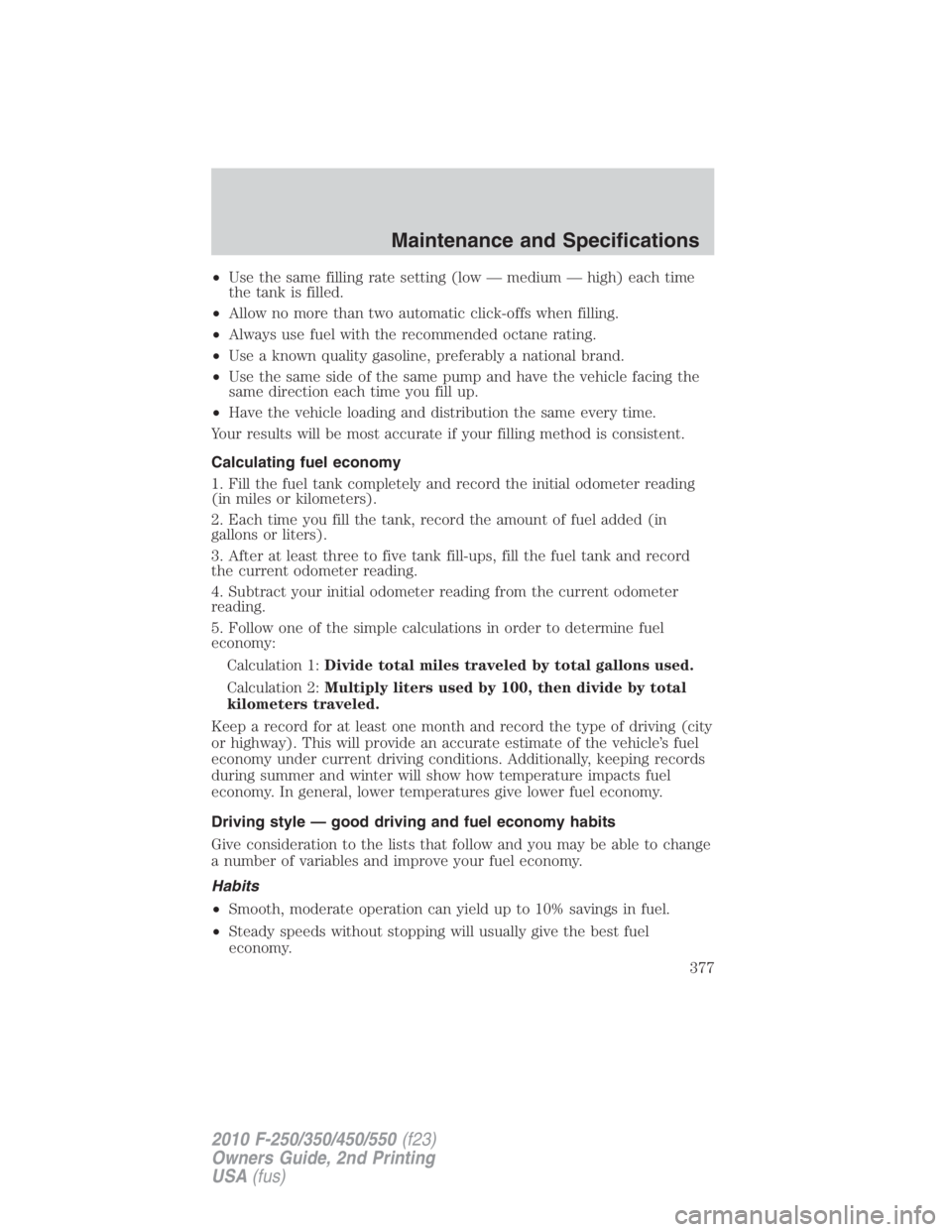2010 FORD F550 fuel type
[x] Cancel search: fuel typePage 7 of 408

Notice to owners of diesel-powered vehicles
Read the 6.0 and 6.4 Liter Power Stroke Direct Injection Turbo Diesel
Owner’s Guide Supplement for information regarding correct operation
and maintenance of your Diesel-powered light truck.
Notice to owners of pickup trucks and utility type vehicles
WARNING: Utility vehicles have a significantly higher rollover
rate than other types of vehicles.
Before you drive your vehicle, please read this Owner’s Guide carefully.
Your vehicle is not a passenger car. As with other vehicles of this type,
failure to operate this vehicle correctly may result in loss of vehicle
control, vehicle rollover, personal injury or death.
Using your vehicle with a snowplow
For more information and guidelines for using your vehicle with a
snowplow, refer to the Driving chapter.
Using your vehicle as an ambulance
If your light truck is equipped with the Ford Ambulance Preparation
Package, it may be utilized as an ambulance. Ford urges ambulance
manufacturers to follow the recommendations of the Ford Incomplete
Vehicle Manual, Ford Truck Body Builder’s Layout Book and the
Qualified Vehicle Modifiers (QVM) Guidelines as well as pertinent
supplements. For additional information, please contact the Truck Body
Builders Advisory Service at http://www.fleet.ford.com/truckbbas/ and
then by selecting “Contact Us” or by phone at 1–877–840–4338.
Use of your Ford light truck as an ambulance, without the Ford
Ambulance Preparation Package voids the Ford New Vehicle Limited
Warranty and may void the Emissions Warranties. In addition, ambulance
usage without the preparation package could cause high underbody
temperatures, overpressurized fuel and a risk of spraying fuel which
could lead to fires.
If your vehicle is equipped with the Ford Ambulance Preparation
Package, it will be indicated on the Safety Compliance Certification
Label. The label is located on the driver’s side door pillar or on the rear
edge of the driver’s door. You can determine whether the ambulance
manufacturer followed Ford’s recommendations by directly contacting
that manufacturer. Ford Ambulance Preparation Package is only available
on certain Diesel engine equipped vehicles. Introduction
7
2010 F-250/350/450/550 (f23)
Owners Guide, 2nd Printing
USA (fus)
Page 28 of 408

In the event of a multiple warning situation, the message center will
cycle the display to show all warnings by displaying each one for four
seconds.
The message center will display the last selected feature if there are no
more warning messages.
Types of messages and warnings:
• Some messages will appear briefly to inform you of something you
may need to take action on or be informed of.
• Some messages will appear once and then again when the vehicle is
restarted.
• Some messages will reappear after clearing or being reset if a problem
or condition is still present and needs your attention.
• Some messages can be acknowledged and reset by pressing the
SELECT/RESET button. This allows you to use the full message
center functionality by clearing the message.
PARK BRAKE ENGAGED — Displayed when the parking brake is
applied (or not fully released).
CHECK BRAKE SYSTEM — Displayed when a fault has been detected
by the ABS module.
DRIVER DOOR AJAR — Displayed when the driver’s door is not
completely closed.
PASSENGER DOOR AJAR — Displayed when the passenger’s door is
not completely closed.
REAR LEFT DOOR AJAR — Displayed when the rear left door is not
completely closed.
REAR RIGHT DOOR AJAR — Displayed when the rear right door is
not completely closed.
XXX MILES TO E FUEL LEVEL LOW — Displayed as an early
reminder of a low fuel condition.
CHECK PARK AID (if equipped) — Displayed when the transmission
is in R (Reverse) and the reverse sensing system (park aid) is disabled.
TO STOP ALARM START VEHICLE (if equipped) — Displayed
when the perimeter alarm system is armed and the vehicle is entered
using the key on the driver’s side door. In order to prevent the perimeter
alarm system from triggering, the ignition must be turned to start or on
before the 12–second chime expires. See Perimeter alarm system in the
Locks and Security chapter.Instrument Cluster
28
2010 F-250/350/450/550 (f23)
Owners Guide, 2nd Printing
USA (fus)
Page 254 of 408

Hitches
WARNING: ON PICK-UP TRUCKS, the trailer hitch provided on
this vehicle enhances collision protection for the fuel system. DO
NOT REMOVE!
Do not mount a ball hitch (sometimes referred to as a trailer ball hitch
or trailer ball) to the bumper or use hitches that clamp onto the vehicle’s
bumper or attach to the axle. You must distribute the load in your trailer
so that 10–15% for conventional towing or 15-25% fifth-wheel towing of
the total weight of the trailer is on the tongue.
Hitch rating
The standard hitch has two ratings depending on mode of operation:
• Weight carrying - requires a draw bar and hitch ball. The draw bar
supports all the vertical tongue load of the trailer.
• Weight distributing - requires an aftermarket weight distributing
system which includes draw bar, hitch ball, spring bars and snap-up
brackets. The vertical tongue load of the trailer is distributed between
the truck and the trailer by this system.
Hitch Type Maximum
Gross Trailer
Weight — lb.
(kg) Maximum
Tongue
Weight — lb.
(kg)
6.8L DRW
Pickup
2.5” ID without
adapter
(requires 2.5”
drawbar) Weight carrying 8000 (3629) 800 (363)
Weight
distributing 15000 (6804) 1500 (680)
6.8L DRW
Pickup
2.5” ID with
adapter
(requires 2”
drawbar) Weight carrying 6000 (2721) 600 (272)
Weight
distributing 12500 (5670) 1250 (567)
All SRW Pickups
and 5.4L DRW
Pickups
2” receiver Weight carrying 6000 (2721) 600 (272)
Weight
distributing 12500 (5670) 1250 (567)Tires, Wheels and Loading
254
2010 F-250/350/450/550 (f23)
Owners Guide, 2nd Printing
USA (fus)
Page 284 of 408

Night time and dark area use
At night time or in dark areas, the camera system relies on the reverse
lamp lighting to produce an image. Therefore it is necessary that both
reverse lamps are operating in order to get a clear image in the dark. If
either of the lamps are not operating, stop using the camera system, at
least in the dark, until the lamp(s) are replaced and functioning.
Servicing
• If the image comes on while the vehicle is not in R (Reverse), have
the system inspected by your authorized dealer.
• If the image is not clear, then check if there is anything covering the
lens such as dirt, mud, ice, snow, etc. If the image is still not clear
after cleaning, have your system inspected by your authorized dealer.
FOUR-WHEEL DRIVE (4WD) OPERATION (IF EQUIPPED)
WARNING: For important information regarding safe operation
of this type of vehicle, see Preparing to drive your vehicle in
this chapter.
When four–wheel drive (4WD) is engaged, power is supplied to all four
wheels through a transfer case. 4WD can be selected when additional
driving power is desired.
4WD operation is not recommended on dry pavement. Doing so could
result in difficult disengagement of the transfer case, increased tire wear
and decreased fuel economy.
Manual Shift On Stop (MSOS) 4x4 system (if equipped)
The 4WD system is engaged or
disengaged by rotating the control
for both front wheel hub locks from
the FREE or LOCK position, then
manually engaging or disengaging
the transfer case with the
floor-mounted shifter. For increased
fuel economy in 2WD, rotate both
hub locks to the FREE position.Driving
284
2010 F-250/350/450/550 (f23)
Owners Guide, 2nd Printing
USA (fus)
Page 377 of 408

• Use the same filling rate setting (low — medium — high) each time
the tank is filled.
• Allow no more than two automatic click-offs when filling.
• Always use fuel with the recommended octane rating.
• Use a known quality gasoline, preferably a national brand.
• Use the same side of the same pump and have the vehicle facing the
same direction each time you fill up.
• Have the vehicle loading and distribution the same every time.
Your results will be most accurate if your filling method is consistent.
Calculating fuel economy
1. Fill the fuel tank completely and record the initial odometer reading
(in miles or kilometers).
2. Each time you fill the tank, record the amount of fuel added (in
gallons or liters).
3. After at least three to five tank fill-ups, fill the fuel tank and record
the current odometer reading.
4. Subtract your initial odometer reading from the current odometer
reading.
5. Follow one of the simple calculations in order to determine fuel
economy:
Calculation 1: Divide total miles traveled by total gallons used.
Calculation 2: Multiply liters used by 100, then divide by total
kilometers traveled.
Keep a record for at least one month and record the type of driving (city
or highway). This will provide an accurate estimate of the vehicle’s fuel
economy under current driving conditions. Additionally, keeping records
during summer and winter will show how temperature impacts fuel
economy. In general, lower temperatures give lower fuel economy.
Driving style — good driving and fuel economy habits
Give consideration to the lists that follow and you may be able to change
a number of variables and improve your fuel economy.
Habits
• Smooth, moderate operation can yield up to 10% savings in fuel.
• Steady speeds without stopping will usually give the best fuel
economy. Maintenance and Specifications
377
2010 F-250/350/450/550 (f23)
Owners Guide, 2nd Printing
USA (fus)
Page 378 of 408

• Idling for long periods of time (greater than one minute) may waste
fuel.
• Anticipate stopping; slowing down may eliminate the need to stop.
• Sudden or hard accelerations may reduce fuel economy.
• Slow down gradually.
• Driving at reasonable speeds (traveling at 55 mph [88 km/h] uses 15%
less fuel than traveling at 65 mph [105 km/h]).
• Revving the engine before turning it off may reduce fuel economy.
• Using the air conditioner or defroster may reduce fuel economy.
• You may want to turn off the speed control in hilly terrain if
unnecessary shifting between the top gears occurs. Unnecessary
shifting of this type could result in reduced fuel economy.
• Warming up a vehicle on cold mornings is not required and may
reduce fuel economy.
• Resting your foot on the brake pedal while driving may reduce fuel
economy.
• Combine errands and minimize stop-and-go driving.
Maintenance
• Keep tires properly inflated and use only recommended size.
• Operating a vehicle with the wheels out of alignment will reduce fuel
economy.
• Use recommended engine oil. Refer to Maintenance product
specifications and capacities in this chapter.
• Perform all regularly scheduled maintenance items. Follow the
recommended maintenance schedule and owner maintenance checks
found in scheduled maintenance information.
Conditions
• Heavily loading a vehicle or towing a trailer may reduce fuel economy
at any speed.
• Carrying unnecessary weight may reduce fuel economy (approximately
1 mpg [0.4 km/L] is lost for every 400 lb [180 kg] of weight carried).
• Adding certain accessories to your vehicle (for example bug
deflectors, rollbars/light bars, running boards, ski/luggage racks) may
reduce fuel economy.
• To maximize the fuel economy, drive with the tonneau cover installed
(if equipped).Maintenance and Specifications
378
2010 F-250/350/450/550 (f23)
Owners Guide, 2nd Printing
USA (fus)